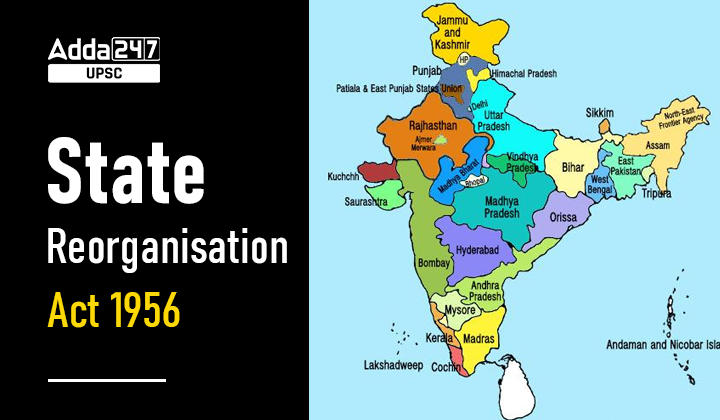Table of Contents
States Reorganisation Act 1956: Introduction
- During the work of the Constituent Assembly demands for the linguistic reorganization of states were raised. But the leaders thought that immediately after partition, the creation of linguistic states might create further tension. So the decision was postponed.
- But Parliament was given the power to create new states or merge old states or parts of such states or alter their boundaries in the future.
States Reorganisation Act 1956: Creation of Andhra State
- Shortly after the making of the Constitution, the agitation for an Andhra State began. Potti Sriramulu, a respected Andhra Congress leader, fasted unto death demanding the creation of the Andhra State on a linguistic basis.
- As a result on October 01, I953 the Andlira State was carved out of the State of Madras.
States Reorganisation Act 1956: Commissions/Committees for State Reorganization
Dhar Commission
- In the wake of demands from all quarters for new states, a Linguistic Provinces Commission (also called Dhar Commission), under the Chairmanship of S.K. Dhar, was set up by the President of the Indian Constituent Assembly in 1948 to consider the question of reorganization of states in India.
- The Commission in its report recommended that the reorganization of states should be on the basis of administrative convenience rather than on linguistic basis.
JVP Committee
- The Indian National Congress in its Jaipur Session set up a high level committee called Linguistic Provinces Committee – consisting of Jawaharlal Nehru, Vallabhbhai Patel and Pattabhi Sitaramiah (JVP Committee) to consider the Dhar Commission’s recommendation.
- In its report, the committee counselled utmost caution in proceeding with the proposal for the linguistic reorganization of States.
States Reorganization Commission (1953)
- In 1953, GOI was forced to create the first linguistic state, the state of Andhra, by separating the 16-Telugu speaking districts of Madras state, comprising of the Coastal Andhra and Rayalaseema Regions.
- Subsequently, Jawaharlal Nehru appointed the States Reorganization Commission (1953), under the chairmanship of Fazl Ali to examine the whole question.
- The other two members of the Commission were KM Panikkar and HN Kunzru. In 1955, the Commission submitted its report.
- While laying down that due consideration should be given to administrative and economic factors, it recognized for the most part the linguistic principle and recommended redrawing of state boundaries on that basis.
States Reorganisation Act 1956: What is State Reorganisation Act 1956?
- The State Reorganisation Act was passed by the Parliament in November 1956.
- It provided for fourteen states and six centrally administered territories.
- The Constitutional(Seventh) Amendment Act was passed to replace the four types of states, known as Part A, B, C and D.
List of Part A, B, C & D states
|
States Reorganisation Act 1956: Did States Reorganisation Act 1956 make any drastic change?
- The States Reorganisation Act, 1956 did not make a drastic rcorganisation. The former Part B State of Hyderabad was joined with Andhra State to form a larger Andhra Pradesh State.
- The former Part B State of Mysore turned into a larger State of Karnataka with additional territories transferred from the States of Madras (Tamil Nadu) and Bombay.
- The former Part B State of Travancore-Cochin was turned into the State of Kerala with new Territories acquired from the State of Madras.
States Reorganisation Act 1956: Did States Reorganization Commission create new states?
- States Reorganization Commission of 1955 did not create any new state.
- The Commission actually integrated several former Princely States on the basis of language.
- The Commission was not in favor of many states though it recommended the creation of one new state – Vidarbha-by uniting contiguous territories of Madhya Pradesh and the then State of Bombay.
- That recommendation was not accepted by the government. On the other hand, Bombay state was enlarged by the transfer of territory from Madhya Pradesh.
States Reorganisation Act 1956: 3 Phases of reorganization of states
The reorganization of existing state boundaries since the consolidation of the Indian Union in 1950 can be broadly classified under three broad phases.
- The first major reorganization occurred in 1956 following a nationwide movement for the creation of linguistically compact provinces.
- The second major initiative came in the 1970s, when the Northeast was split up and several new states were created following the establishment of Nagaland in 1963.
- The third phase marked the creation of Jharkhand, Uttaranchal and Chhattisgarh in the Northern provinces of India.
States Reorganisation Act 1956: How reorganization cleared the ground for national integration?
- The reorganization resulted in rationalizing the political map of India, without seriously weakening its unity.
- The Linguistic reorganization during the 1950s was a major development in incorporating cultural identities into political and administrative units.
- By reorganizing the states on Linguistic lines, the national leadership removed a major grievance that could have led to fissiparous tendencies.
- States reorganization is, therefore, ‘best regarded as clearing the ground for national integration.’


 TSPSC Group 1 Question Paper 2024, Downl...
TSPSC Group 1 Question Paper 2024, Downl...
 TSPSC Group 1 Answer key 2024 Out, Downl...
TSPSC Group 1 Answer key 2024 Out, Downl...
 Cabinet Ministers of India 2024, New Cab...
Cabinet Ministers of India 2024, New Cab...







